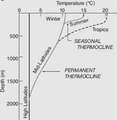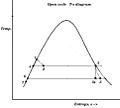Ocean thermal energy conversion facts for kids
Ocean thermal energy conversion (OTEC) is a special way to get useful energy from the world's oceans. The sun warms the surface water in hot parts of the world, sometimes up to 30 °C. But if you go very deep, like 1,000 meters down, the water is much colder, around 5 °C.
OTEC uses this temperature difference to make electricity. Even a small difference, like 15 °C, can be used by a special machine called a heat engine. This machine can turn the heat difference into power that people can use.
How OTEC Works
An OTEC machine needs lots of warm water from the surface and lots of cold water from deep down. It brings both types of water through pipes to the machine. Even though the temperature difference is small, the ocean has huge amounts of water. This means OTEC can produce a lot of energy.
Experts believe OTEC could create 10 to 100 times more energy than other ocean energy sources, like wave power.
History and Power of OTEC
The very first OTEC machine was built in Cuba in 1930. It made 22 kW of electricity, which is enough to power a few homes. The biggest OTEC machine built so far was made by the US in 1999. It generated 250 kW of power. There are plans to build even larger machines that could make around 10 MW of electricity. This would be enough to power a small town!
Other Uses of OTEC
OTEC doesn't just make electricity. It also produces cold water as a side product. This cold water can be used for refrigeration, which helps keep things cool. It can also help crops and fish grow better.
Another great thing about OTEC is that it can make large amounts of fresh, salt-free water. This is very helpful for islands in the middle of the ocean, where drinking water can be hard to find.
Images for kids
-
View of a land based OTEC facility at Keahole Point on the Kona coast of Hawaii
See also
 In Spanish: Energía maremotérmica para niños
In Spanish: Energía maremotérmica para niños







